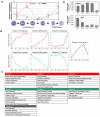Single-lineage transcriptome analysis reveals key regulatory pathways in primitive erythroid progenitors in the mouse embryo
- PMID: 21263157
- PMCID: PMC3100699
- DOI: 10.1182/blood-2010-10-313676
Single-lineage transcriptome analysis reveals key regulatory pathways in primitive erythroid progenitors in the mouse embryo
Abstract
Primitive erythroid (EryP) progenitors are the first cell type specified from the mesoderm late in gastrulation. We used a transgenic reporter to image and purify the earliest blood progenitors and their descendants from developing mouse embryos. EryP progenitors exhibited remarkable proliferative capacity in the yolk sac immediately before the onset of circulation, when these cells comprise nearly half of all cells of the embryo. Global expression profiles generated at 24-hour intervals from embryonic day 7.5 through 2.5 revealed 2 abrupt changes in transcript diversity that coincided with the entry of EryPs into the circulation and with their late maturation and enucleation, respectively. These changes were paralleled by the expression of critical regulatory factors. Experiments designed to test predictions from these data demonstrated that the Wnt-signaling pathway is active in EryP progenitors, which display an aerobic glycolytic profile and the numbers of which are regulated by transforming growth factor-β1 and hypoxia. This is the first transcriptome assembled for a single hematopoietic lineage of the embryo over the course of its differentiation.
Figures






Comment in
-
Erythropoiesis: early, not primitive.Blood. 2011 May 5;117(18):4685-6. doi: 10.1182/blood-2011-02-334573. Blood. 2011. PMID: 21546468 No abstract available.
References
-
- Kinder SJ, Tsang TE, Quinlan GA, Hadjantonakis AK, Nagy A, Tam PP. The orderly allocation of mesodermal cells to the extraembryonic structures and the anteroposterior axis during gastrulation of the mouse embryo. Development. 1999;126(21):4691–4701. - PubMed
-
- Haar JL, Ackerman GA. A phase and electron microscopic study of vasculogenesis and erythropoiesis in the yolk sac of the mouse. Anat Rec. 1971;170(2):199–223. - PubMed
-
- Wong PM, Chung SW, Reicheld SM, Chui DH. Hemoglobin switching during murine embryonic development: evidence for two populations of embryonic erythropoietic progenitor cells. Blood. 1986;67(3):716–721. - PubMed
-
- Palis J, Robertson S, Kennedy M, Wall C, Keller G. Development of erythroid and myeloid progenitors in the yolk sac and embryo proper of the mouse. Development. 1999;126(22):5073–5084. - PubMed
Publication types
MeSH terms
Substances
Grants and funding
- DK084391/DK/NIDDK NIH HHS/United States
- R01 HD052115/HD/NICHD NIH HHS/United States
- R01 HL62248/HL/NHLBI NIH HHS/United States
- EB02209/EB/NIBIB NIH HHS/United States
- DK52191/DK/NIDDK NIH HHS/United States
- R01 DK062039/DK/NIDDK NIH HHS/United States
- R01 HL65448/HL/NHLBI NIH HHS/United States
- R24 CA088302/CA/NCI NIH HHS/United States
- R01 DK084391/DK/NIDDK NIH HHS/United States
- R01 HL062248/HL/NHLBI NIH HHS/United States
- R24 CA88302/CA/NCI NIH HHS/United States
- P30 DK072442/DK/NIDDK NIH HHS/United States
- DK62039/DK/NIDDK NIH HHS/United States
- P30 CA008748/CA/NCI NIH HHS/United States
- R01 DK052191/DK/NIDDK NIH HHS/United States
- R01 HL065448/HL/NHLBI NIH HHS/United States
- R01 EB002209/EB/NIBIB NIH HHS/United States
LinkOut - more resources
Full Text Sources
Other Literature Sources
Molecular Biology Databases

